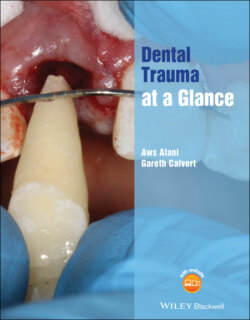Читать книгу Dental Trauma at a Glance - Aws Alani - Страница 13
Оглавление2 Prevention of dental trauma
Figure 2.1 An example of a ‘boil in the bag’ mouth guard.
Figure 2.2 A correctly extended maxillary mouth guard covering the teeth and soft tissue following the depth of the sulcus.
Figure 2.3 An incorrectly extended maxillary mouth guard not covering the soft tissues adequately into the sulcus leaving this area unprotected.
Figure 2.4 Helmets for bike travel can reduce injury severity.
Figure 2.5 Orthodontics reducing an increased overjet.
Introduction
The majority of traumatic dental injuries can happen unexpectedly during daily life. This makes their complete prevention practically impossible. Therefore education on avoidance, reduction and the correct acute management may go some way in reducing the severity of injuries, making them easier to manage once they present to the clinician.
The following are some active steps that can be taken to avoid or reduce injuries to the dental hard and soft tissues.
Mouth guards
It is recommended that all athletes wear a mouth guard or gum shield to minimise any impact and reduce the prevalence of traumatic dental injuries (Fernandes et al. 2019). The mode of protection provided by a mouth guard varies depending on the direction and energy of the impact.
There are three types of mouth guard:
Stock (universal)
Mouth‐formed (boil and bite) (Figure 2.1)
Custom‐made (fabricated by a dental professional) (Figure 2.2)
While custom‐made mouth guards from a dentist are more costly, they provide the best comfort and protection against dental trauma (Johnston and Messer 1996). Furthermore, the cost of a customised mouth guard is insignificant when compared to the financial outlay of the provision and subsequent lifelong maintenance of traumatised teeth or their prosthodontic replacement.
Ideal features of mouth guards
Absorb and deflect frontal or axial impacts.
Protect the oral soft tissue as well as the hard tissues (Figure 2.2).
Support the mandible when in occlusion from crown‐root fractures and mandibular jaw fracture.
Common pitfalls
Underextension over the gingiva and mucosa (Figure 2.3). The teeth and soft tissues should be covered to increase protection, retention, and strength of the mouth guard.
Underextension over posterior units. The mouth guard should extend over at least one molar each side for retention and occlusal stability.
Palatal extension. The mouth guard should extend palatally in the anterior region for strength and retention.
Thickness. If too thick, the wearer my struggle with comfort or breathing. If too thin, there will be no protective benefit.
Helmet
Wearing a helmet (Figure 2.4) or face mask for motorsports, bicycle riding, and those who use motorbikes to commute has been shown to reduce maxillofacial injuries by up to 50% (Kelly et al. 1991; Benson et al. 1999).
Unfortunately, cyclists still experience a high prevalence of dental trauma as few wear mouth guards.
Seat belts
This is a legal requirement when traveling in a motor vehicle. The use of seat belts has been shown to significantly decrease the frequency of facial injuries (Reath et al. 1989).
Overjet reduction
An increased overjet of more than 6 mm is associated with a higher prevalence of dental trauma. Therefore, orthodontic treatment to reduce the overjet should be considered in these patients (Figure 2.5).
Past experience
People with a history of dental trauma are almost three times more likely to experience another episode of dental trauma. Therefore in this cohort, these preventative measurements should be strongly considered.
Key Points
These relatively simple measures should be reinforced as they reduce the long term burden of traumatic dental injuries.
